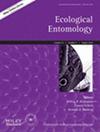Pollinator visitation decline due to pesticide application beyond threshold frequency brings down crop yield
IF 1.6
3区 农林科学
Q2 ENTOMOLOGY
引用次数: 0
Abstract



杀虫剂施用频率超过阈值导致传粉昆虫来访减少,从而降低了作物产量
农药对授粉昆虫数量的有害影响已得到充分证实,但农药施用、授粉昆虫减少和相应的可销售产量变化之间的关系还没有得到充分了解。在这项研究中,我们评估了农药暴露的程度会导致授粉昆虫的最大损失,以及在这一程度上的授粉昆虫损失是否会导致作物减产。我们主要评估了 27 个不同农药施用量的茄子农场中授粉昆虫对作物花朵的光顾情况。随后,我们还在一个采用四种不同农药处理的半对照田间试验中观察了授粉昆虫的活动和茄子产量(坐果率)。与数量相比,农药施用频率是授粉昆虫造访的最重要驱动因素。每周喷洒一次以上的农药会导致传粉昆虫来访量急剧下降,这种非线性方式显示了农药施用的阈值。在喷洒农药频率较高的实验地块,传粉昆虫的到访量明显低于对照地块、低频地块和中频地块。这导致高农药频率地块的茄子坐果率降低了 27.4%。使用合成杀虫剂来保障产量似乎适得其反,因为杀虫剂导致授粉昆虫受限,从而降低了产量。
本文章由计算机程序翻译,如有差异,请以英文原文为准。
求助全文
约1分钟内获得全文
求助全文
来源期刊

Ecological Entomology
生物-昆虫学
CiteScore
4.90
自引率
4.50%
发文量
94
审稿时长
3 months
期刊介绍:
Ecological Entomology publishes top-quality original research on the ecology of insects and related invertebrate taxa. Our aim is to publish papers that will be of considerable interest to the wide community of ecologists who are motivated by ecological or evolutionary theory. The suitability of a manuscript will usually be assessed within 5 days.
We publish full-length Original Articles as well as Reviews, Short Communications, Methods and Natural History papers. In Original Articles, we greatly prefer papers that test specific hypotheses and which have a high degree of novelty. All categories aim for innovative contributions that advance the subject of ecological entomology.
 求助内容:
求助内容: 应助结果提醒方式:
应助结果提醒方式:


